Hydroponics Gardening: Elevating Your Garden Game
Embarking on the journey of gardening has been a personal odyssey for me, navigating through soil, sunlight, and seasons to nurture the greenery that brings life to any space. Yet, amidst my horticultural pursuits, it was the revolutionary realm of hydroponic gardening that captivated my imagination like never before. This Hydroponics Gardening article allows me to weave a narrative of my passion, sharing the insights I’ve gathered as an avid hydroponics advisor.
Join me in uncovering the secrets of this soil-free marvel as I provide valuable suggestions fueled by both hands-on experience and the intriguing science that underscores each verdant success. Whether you’re a seasoned green thumb or a budding enthusiast, get ready to delve into the world where roots don’t just run deep—they thrive without soil, embracing a future where gardening knows no bounds.
What is hydroponics?
Hydroponics, at its core, is a captivating dance between science and nature, transforming the conventional art of gardening. Imagine a world where plants flourish not in the embrace of soil but suspended in a nutrient-enriched water solution—an innovative ballet that redefines the very essence of cultivation. In this article, we unravel the secrets that lie beneath the surface of hydroponics gardening, a method where roots relinquish the earthly confines to thrive in a meticulously controlled aquatic environment.
Join me in exploring the science that propels this horticultural evolution, unlocking the doors to accelerated growth and bountiful yields. Get ready to dive into the aqueous realms of precision and possibility, where each drop of nutrient-rich water holds the promise of a flourishing future for your green companions.
Historical Context
Embark on a captivating journey through time, where the ancient Aztecs ingeniously cultivated floating gardens, laying the groundwork for what we now marvel at as hydroponics. Far from being a mere modern innovation, hydroponics carries with it the echoes of ancient wisdom, a testament to the age-old quest for innovative solutions in agriculture. Fast forward to the present and witness the metamorphosis of hydroponics into a cutting-edge, highly efficient system that has seamlessly blended the wisdom of the past with the technology of today. It’s not just about growing crops; it’s a tale of evolution, innovation, and the artistry of sustainable cultivation that transcends the boundaries of time.
Why Choose Hydroponics Gardening

Environmental Benefits
One of the primary reasons I’m drawn to hydroponics is its environmentally friendly nature. With reduced water usage and minimal soil erosion, hydroponics has a significantly lower environmental footprint compared to traditional gardening. Hydroponic systems are known for their water efficiency. By recirculating water and nutrients, they use up to 90% less water compared to conventional soil-based gardening. In a world where water scarcity is a growing concern, this eco-friendly approach can make a significant impact.
Year-Round Growing
Hydroponics allows you to grow plants year-round, regardless of the weather outside. This means fresh, homegrown produce on your table, even in the depths of winter. You’re no longer at the mercy of the seasons. Moreover, hydroponic systems offer precise control over environmental factors like temperature, humidity, and light. This makes it possible to create optimal conditions for plant growth, ensuring that your crops thrive, no matter the time of year.
Setting Up Your Hydroponic Garden
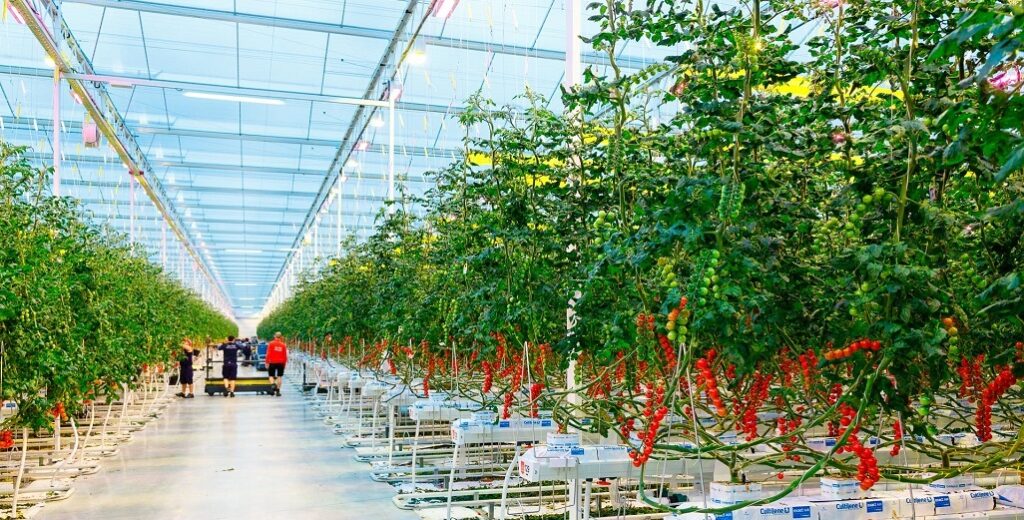
There are various hydroponic systems to choose from, such as Deep Water Culture, Nutrient Film Technique, and Drip Systems. Each has its advantages and best-suited plants. Select the one that aligns with your gardening goals.
1. Deep Water Culture (DWC)
In this system, plants are suspended in a nutrient solution with the roots submerged in water. An air pump oxygenates the solution, promoting root health. DWC is excellent for fast-growing plants like lettuce and herbs.
2. Nutrient Film Technique (NFT)
NFT systems use a continuous flow of nutrient solution to create a thin film of water over the roots. This method is ideal for growing smaller, lightweight plants like spinach and baby greens.
3. Drip Systems
Drip systems deliver a nutrient solution to the base of each plant through a network of tubes and emitters. They are versatile and suitable for a wide range of crops, from tomatoes to cucumbers.
Essential Equipment
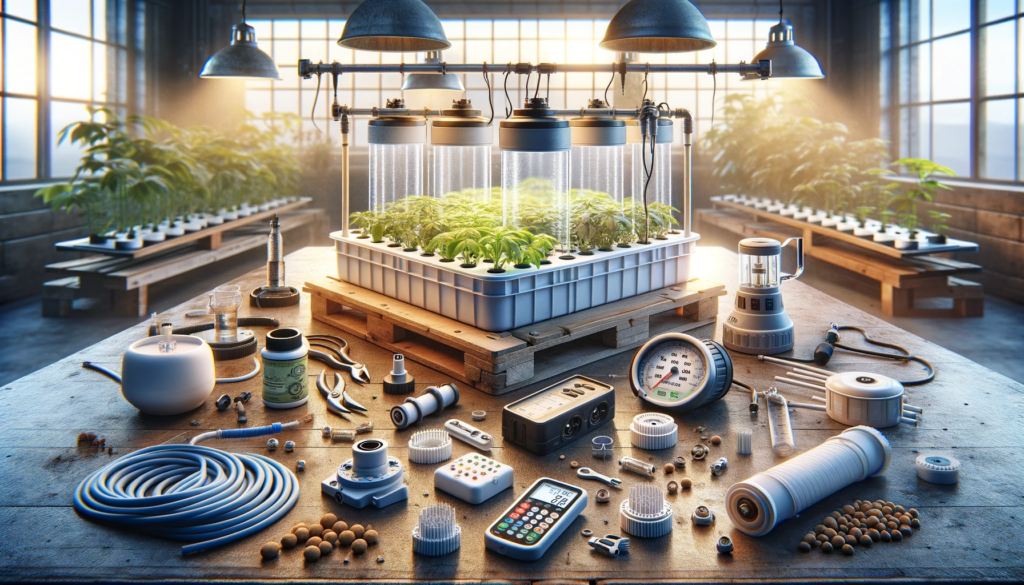
To embark on your journey toward a thriving hydroponic garden, you’ll want to arm yourself with the essential tools of the trade—the backbone of your verdant oasis. Picture a world where you’re the master orchestrator, weaving together the elements that will nourish your plants to perfection.
Grow Trays: Think of these as the cradles for your green darlings. These trays are not just any trays; they’re the sturdy, dependable workhorses that will carry the weight of your botanical aspirations. When choosing your grow trays, opt for ones that are not only resilient but also designed with durability in mind. They’re like the sturdy foundations of a skyscraper, ensuring your crops stand tall and strong.
Pumps and Timers: Meet the heartbeat and rhythm of your hydroponic kingdom—pumps and timers. These ingenious devices automate the circulation of the life-giving nutrient solution, ensuring that each plant receives its fair share at precisely the right moment. Like the conductor of an orchestra, they synchronize the nutrient flow, transforming your garden into a harmonious symphony of growth. No more manual pouring or guesswork; it’s the precision of automation at your fingertips.
pH Meters: In the hydroponic realm, balance is key, and maintaining the perfect pH level for your nutrient solution is paramount. Here’s where pH meters come into play:. They’re the vigilant guardians of your plant’s well-being, constantly monitoring and adjusting the pH to create the ideal environment for growth. Think of them as the caretakers of your garden’s health, ensuring that your green companions flourish and thrive.
Choosing the Best Plants
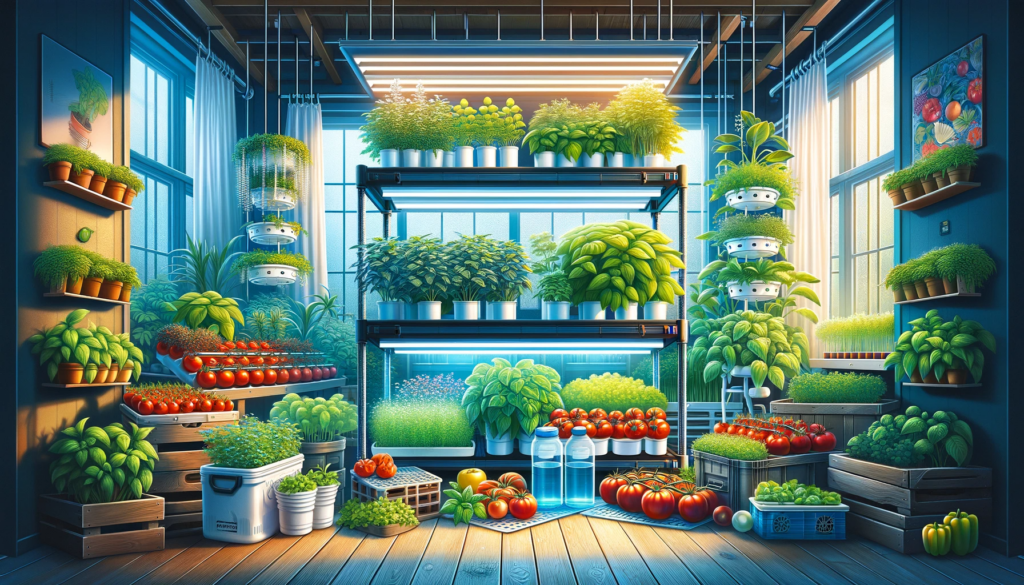
Consider factors like growth rate, nutrient requirements, and space when choosing your plants. Some plants are better suited for hydroponics due to their adaptability to soilless conditions. It’s important to research the specific needs of the plants you intend to grow. For instance, if you’re growing tomatoes, they benefit from support like trellises or stakes. Leafy greens like lettuce and spinach thrive in systems with a constant flow of nutrient solutions.
Hydroponics is incredibly versatile and can accommodate a wide range of plants, from tomatoes and lettuce to basil and mint. Your plant selection should be based on your preferences and available space.
Tomatoes: Hydroponically grown tomatoes are renowned for their intense flavor. They thrive in systems like DWC or drip systems.
Lettuce: This leafy green is one of the easiest crops to grow hydroponically. NFT systems work well for lettuce.
Basil: Herbs like basil grow exceptionally well in hydroponic systems. Their aromatic leaves are a chef’s delight.
Cucumbers: These vining plants can produce an abundance of fruits in a hydroponic setup with proper support.
Strawberries: Hydroponic strawberries are known for their sweetness. Grow them in vertical towers for efficient use of space.
Nutrient Solutions
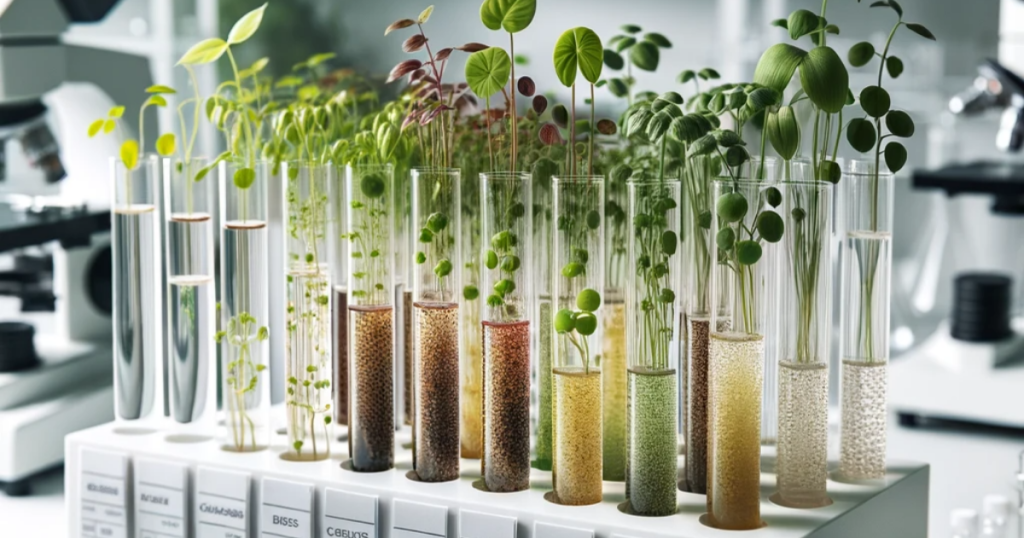
Understanding the Basics
Nutrient solutions are the lifeblood of hydroponics. Understand the essential nutrients your plants need, including nitrogen, phosphorus, and potassium.
Nitrogen (N): This nutrient promotes leafy growth and vibrant green color in plants.
Phosphorus (P): Phosphorus is essential for root development, flowering, and fruit production.
Potassium (K): Potassium aids in overall plant health, from disease resistance to photosynthesis.
Hydroponic nutrient solutions also contain secondary nutrients and micronutrients like calcium, magnesium, and iron. These ensure that plants receive a well-rounded diet.
DIY vs. Commercial Nutrients
You can choose to make your nutrient solutions from scratch or purchase commercial ones. Each option has its advantages.
DIY Nutrient Solutions:
Creating your nutrient solutions allows for customization. You can adjust nutrient levels based on your plant’s specific needs. However, it requires more research and can be time-consuming.
Commercial Nutrients:
Pre-formulated hydroponic nutrient solutions are convenient and reliable. They are designed to provide the right balance of nutrients for different growth stages. This is an excellent choice for beginners or those looking for a hassle-free option.
Lighting and Temperature Control

Proper lighting and temperature control are crucial for plant growth. Ensure your garden has the right balance of light and maintains the ideal temperature.
Light Requirements:
Hydroponic plants need adequate light for photosynthesis. While natural sunlight is an option, artificial grow lights are more controllable and effective. LED (light-emitting diode) and HID (high-intensity discharge) lights are popular choices for hydroponics. LED lights are energy-efficient and produce less heat, making them a great choice for smaller setups. HID lights, on the other hand, emit intense light and are ideal for larger gardens.
Temperature:
Most plants thrive in temperatures between 70°F and 75°F (21°C and 24°C). Keep your hydroponic garden within this range to ensure optimal growth. Maintain a stable temperature, and consider using fans or heaters to regulate it.
Maintenance and Care
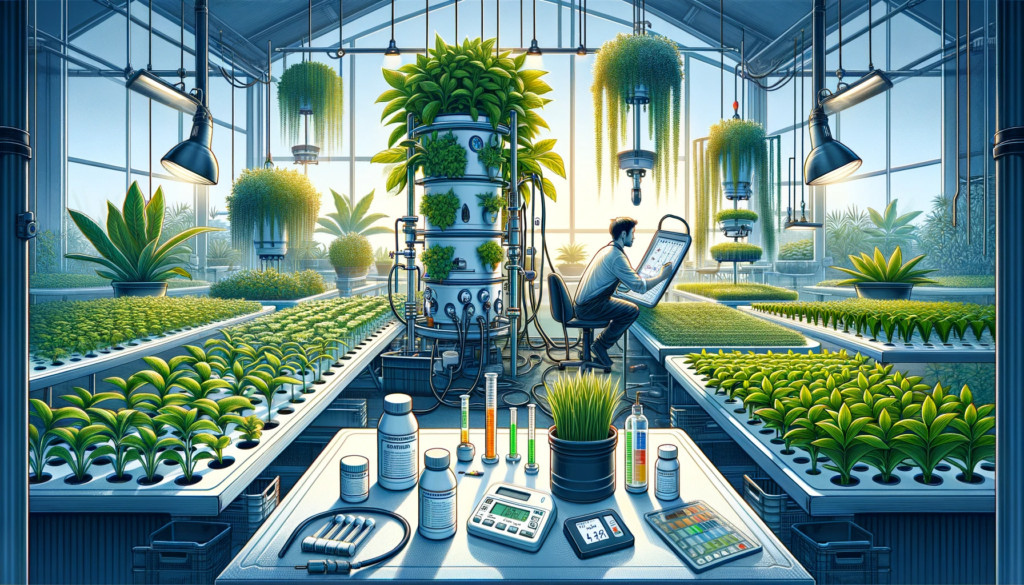
Regularly check nutrient levels to prevent deficiencies or excesses. Adjust the nutrient solution as needed to keep your plants healthy.
pH Levels:
The pH level of your nutrient solution should typically be in the range of 5.5 to 6.5. Monitoring pH is crucial because it affects nutrient absorption. Use pH testing kits or meters to maintain the correct pH.
Electrical conductivity (EC):
EC measures the concentration of dissolved salts in the nutrient solution. It’s an indicator of nutrient strength. Different plants have varying EC requirements, so monitor and adjust as necessary.
Pest and Disease Control
Like any garden, hydroponic systems can be susceptible to pests and diseases. Implement preventive measures and have a plan for dealing with issues.
Pests:
Common pests in hydroponic gardens include aphids, spider mites, and whiteflies. Regularly inspect your plants and use insecticidal soaps or neem oil to manage infestations.
Diseases:
Hydroponic gardens are less prone to soil-borne diseases, but fungal and bacterial issues can still arise. Proper air circulation, humidity control, and cleanliness can help prevent these problems.
Water Management
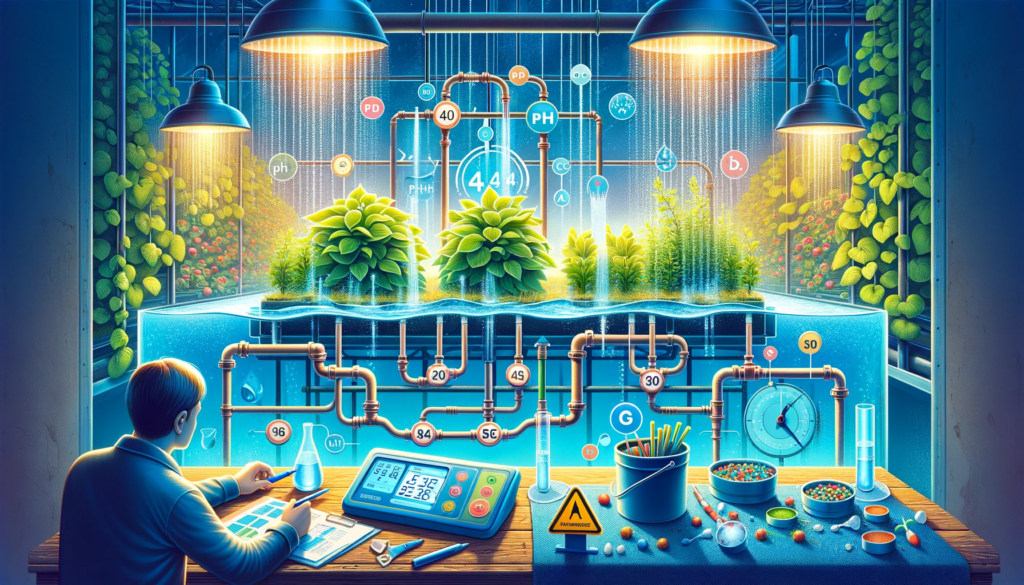
Hydroponics is water-efficient, as it recirculates the nutrient solution. Regularly check the pH and electrical conductivity (EC) levels of the water to ensure optimal conditions. Water management is a significant advantage of hydroponics. Unlike traditional gardening, where water is lost to the ground, hydroponic systems recycle water and nutrients, reducing waste. This is a significant contribution to environmental sustainability.
pH and EC Levels
Maintain the correct pH and EC levels to prevent nutrient imbalances, which can harm your plants’ growth. Be diligent in monitoring and adjusting these parameters.
pH: A stable pH ensures that your plants can absorb nutrients effectively. Use pH adjustment solutions to maintain the desired range.
EC: The EC level determines the strength of your nutrient solution. Different plants require different EC levels at various growth stages. Use EC meters to measure and adjust as needed.
Harvesting and Enjoying Your Produce
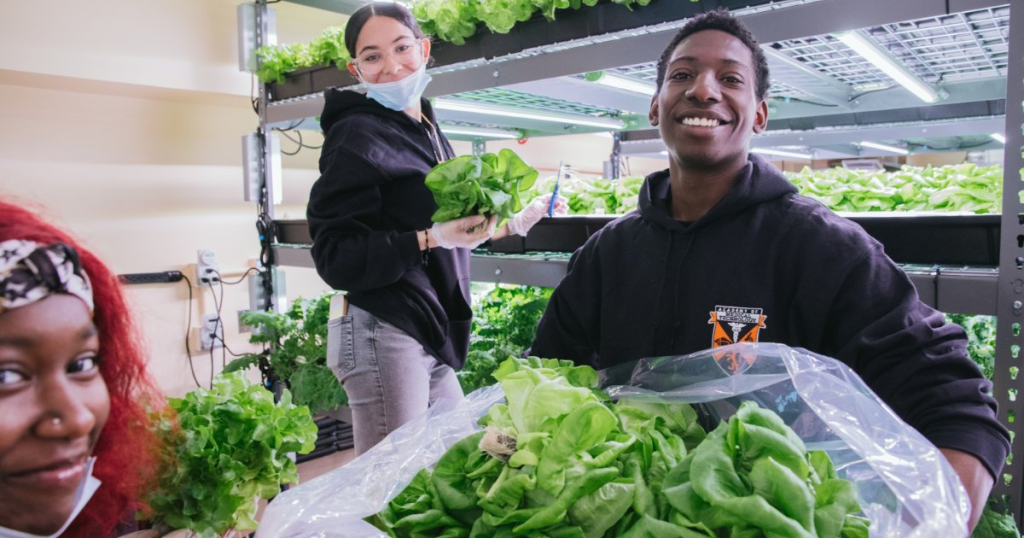
Unlock the art of harvesting for top-tier produce! Elevate your gardening game by delving into these expert techniques, ensuring your hydroponically grown vegetables and herbs reach the zenith of freshness and flavor.
Lettuce: Transform your lettuce harvest into a true culinary delight. Instead of yanking the entire plant, opt for a gentler approach. Skillfully cut the outer leaves, allowing the inner leaves to thrive and maintain a continuous supply of lush greens. This thoughtful method ensures a constant source of fresh, crispy lettuce for your salads.
Tomatoes: Harvesting tomatoes is a delicate affair, and a bit of finesse can make all the difference. When the moment is ripe, gently twist the plump tomatoes from their vines, being careful not to inflict any harm upon the precious plant. This meticulous technique not only guarantees you succulent tomatoes but also preserves the overall health of the plant for future harvests.
Herbs: Elevate your herb garden to new heights with this savvy tip. To encourage bushier growth and maximize your herb yield, expertly snip herbs like basil and mint just above a pair of leaves. This simple yet effective approach not only ensures a continual supply of aromatic herbs but also promotes a lush, vibrant herb garden that will amaze your senses and elevate your culinary creations.
Recipes and Dishes
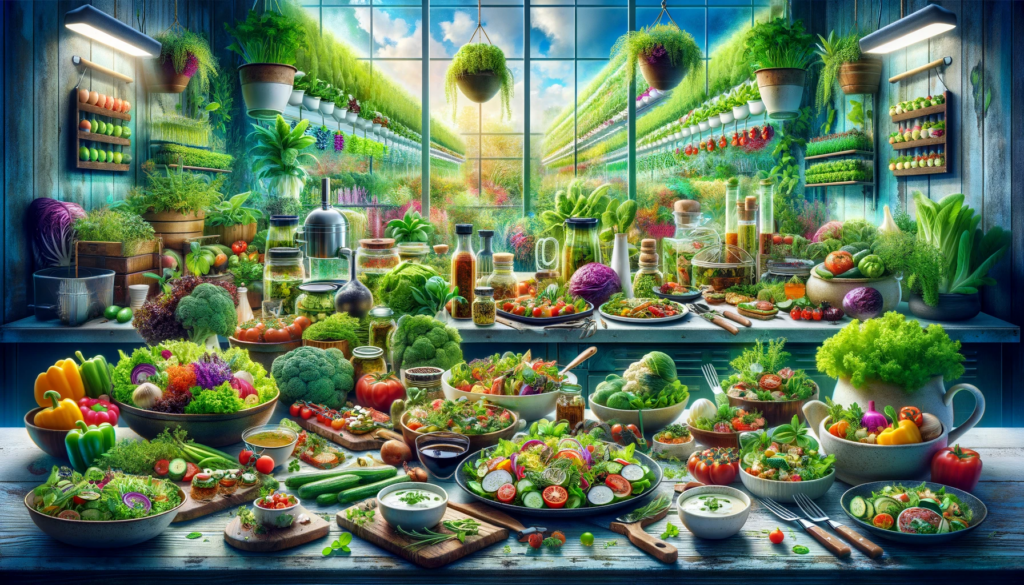
Let’s turn your culinary adventures into a mouthwatering journey with these delectable recipes and dishes, all crafted from your own homegrown hydroponic bounty. Get ready to tantalize your taste buds and embrace the extraordinary flavors that await!
Fresh Salads: Elevate your salads to a whole new level of freshness and nutrition! Utilize the vibrant leafy greens, succulent tomatoes, and aromatic herbs harvested from your hydroponic garden to create tantalizing, nutrient-packed salads that burst with flavor and vitality.
Herb-Infused Dishes: Unleash the power of fresh herbs to elevate your culinary creations. Whether you’re whipping up a zesty pesto or crafting exquisite pasta sauces, these aromatic herbs from your garden will infuse your dishes with an irresistible burst of flavor, turning every meal into a gourmet delight.
Salsa Sensation: Dive into the world of homemade salsa like never before! Your hydroponically nurtured tomatoes, peppers, and herbs are the perfect ingredients for crafting a salsa that’s bursting with freshness and flavor. Say goodbye to store-bought versions and savor the unmatched taste of your own homemade salsa sensation.
Caprese Salad: Create a classic Caprese salad by layering slices of hydroponic tomatoes with fresh mozzarella, basil leaves, and a drizzle of balsamic glaze. It’s a simple yet exquisite appetizer or side dish.
Stir-Fried Vegetables: Whip up a quick and healthy stir-fry using a colorful assortment of hydroponic bell peppers, snap peas, and bok choy. Add your favorite protein and a flavorful sauce for a satisfying meal.
Common Mistakes to Avoid
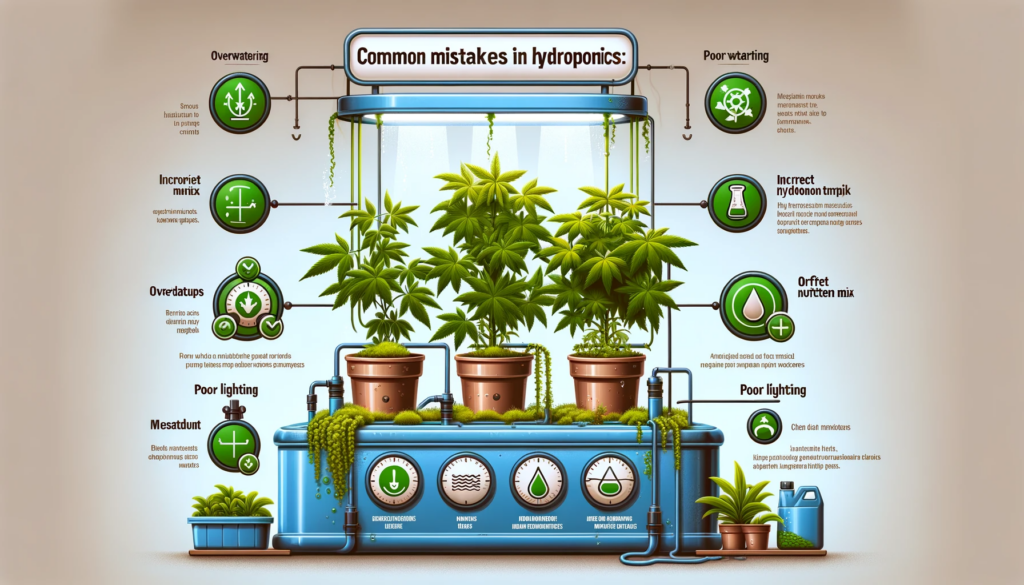
Overloading your plants with nutrients can have adverse effects. Follow the recommended guidelines to avoid overfertilization. Always measure and mix nutrients carefully. Over-fertilization can lead to nutrient imbalances, causing issues like nutrient burn or stunted growth. Adhere to the recommended nutrient ratios for the specific plants you’re growing.
Poor Lighting Choices
Choosing the wrong type or intensity of grow lights can hinder plant growth. Make informed decisions. Opt for LED or HID lights that match the light requirements of your plants. Insufficient lighting can lead to leggy growth, poor fruiting, and reduced yields. Conversely, excessive lighting can cause heat stress and light burns. Adjust the light intensity according to the needs of your plants.
Scaling Up Your Hydroponic Garden
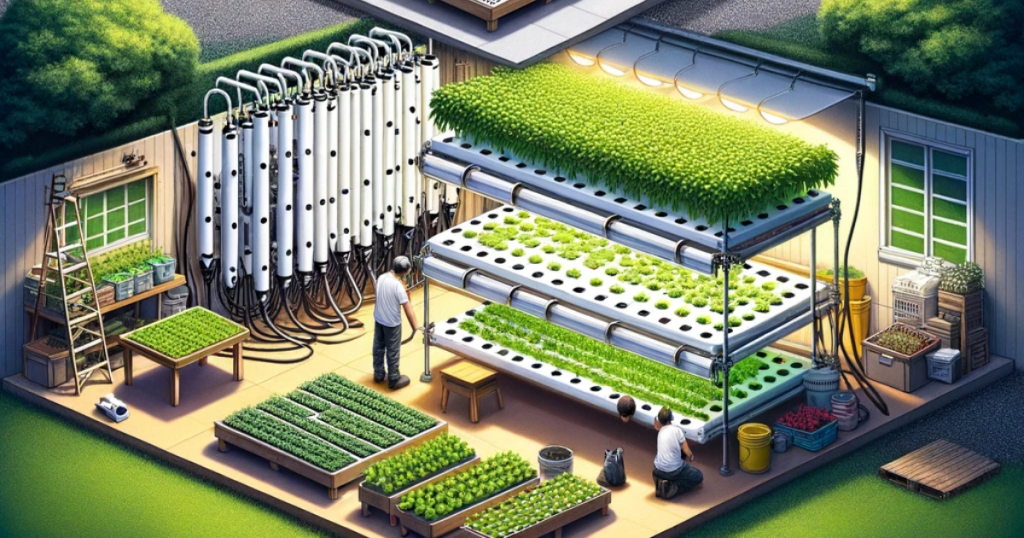
Now that you’ve conquered the fundamentals, get ready to elevate your hydroponic gardening game! It’s time to supercharge your green thumb and expand your hydroponic oasis. Imagine a flourishing haven where a diverse array of plants thrive and your harvests reach new heights. Get ready to unlock the full potential of your hydroponic adventure and watch your yields skyrocket!
Vertical Gardening:
Revolutionize your hydroponic setup by tapping into the power of vertical space! Take your gardening to new heights with multi-tiered hydroponic systems that defy the limits of traditional layouts. This ingenious approach not only supercharges your yield but does so without the need for extra horizontal space. It’s time to think beyond the conventional and elevate your hydroponic game to unprecedented heights.
Greenhouses:
Supercharge your hydroponic ambitions by diving into the world of greenhouses! Picture this: an extended growing season where your plants bask in the perfect, controlled environment. With a greenhouse in your arsenal, you’re not just growing; you’re cultivating a year-round symphony of lush greens and vibrant blooms. Embrace the game-changer that is a greenhouse, and let your hydroponic garden thrive beyond the constraints of the seasons.
Commercial Hydroponics

Enterprising gardeners often transform their hydroponic passion into a thriving business venture. If your heart beats for hydroponics, let’s delve into the exciting world of commercial hydroponics and unlock its boundless potential.
Market Farming: Take your hydroponic passion to the next level by transforming it into a thriving business. Cultivating hydroponically grown produce for sale at local markets and restaurants can be a profitable venture. Not only will you provide your community with fresh, high-quality produce, but you’ll also promote sustainable and eco-friendly farming practices.
Hydroponic Stores: Dive into the heart of the hydroponic revolution by opening your very own hydroponic supply store. As the community of hydroponic gardeners continues to grow, your store will be the go-to destination for essential equipment, nutrients, and expertise. By offering top-notch products and knowledgeable advice, you’ll play a crucial role in nurturing and supporting this dynamic and passionate community.
Consulting Services: Share your hydroponic expertise by offering consulting services to aspiring commercial hydroponic farmers or hobbyists looking to improve their setups. Your knowledge and experience can guide them towards success, and you can establish yourself as a trusted resource in the industry.
Educational Workshops: Organize workshops and training sessions to educate others about the benefits and techniques of hydroponics. Whether it’s for schools, community groups, or individuals looking to learn, these workshops can help spread awareness and grow interest in hydroponics.
Specialty Crop Production: Consider focusing on unique or specialty crops that are well-suited for hydroponic cultivation. Examples include rare herbs, edible flowers, or exotic vegetables. These can command higher prices in niche markets.
Hydroponic Tours: Offer guided tours of your hydroponic facility to schools, tourists, or curious individuals. This not only generates extra income but also raises awareness about hydroponic farming and its sustainability advantages.
Hydroponic Restaurant: Take the farm-to-table concept to the next level by opening a restaurant that exclusively serves dishes made from your hydroponically grown produce. This unique dining experience can attract food enthusiasts and eco-conscious customers alike.
Online Retail: Extend your reach by establishing an online platform for hydroponic supplies and resources. This allows you to cater to a broader audience, including hobbyists and commercial growers from around the world.
Cost Considerations

When planning a hydroponic setup, it’s essential to account for the initial investment in high-quality equipment, the ongoing costs of nutrients, and the utility expenses, primarily electricity. Efficient planning and budgeting in these areas are key to ensuring the sustainability and success of your hydroponic garden.
Equipment Costs:
Initial Investment: Starting a hydroponic garden involves upfront costs such as purchasing growing trays, pumps, and various meters (like pH and EC meters). These items are fundamental to creating an environment conducive to plant growth without soil.
Quality vs. Cost: Opting for high-quality equipment might seem expensive at first, but it often pays off in the long run. Better-quality equipment tends to be more durable and efficient and can offer greater control over the growing environment, leading to healthier plants and potentially higher yields.
Long-Term Considerations: Investing in quality equipment also means lower maintenance costs and fewer frequent replacements. This can lead to cost savings over time, despite the initial higher investment.
Nutrient Costs:
DIY vs. Commercial Nutrients: You have the option of either making your own nutrient solutions or buying pre-made ones. While DIY can be more cost-effective, it requires a good understanding of plant nutrition. Commercial solutions are convenient but can be more expensive.
Ongoing Expense: Regardless of the choice, providing your plants with the right balance of nutrients is an ongoing expense. These nutrients need to be replenished regularly to ensure that plants receive everything they need for optimal growth.
Monitoring and Adjustments: Regular monitoring of nutrient levels is crucial, and adjustments may be needed based on plant growth stages and specific crop needs, adding to the operational costs.
Utility Costs:
Electricity Consumption: Hydroponic systems rely heavily on electricity for lighting, especially if you are using artificial lights in an indoor setup. Pumps for circulating water and possibly air pumps for aerating the nutrient solution are also common electrically powered components.
Water Efficiency vs. Electricity Use: While hydroponics is often lauded for its water efficiency compared to traditional soil-based agriculture, the increased electricity use is a significant trade-off. This aspect needs to be factored into the overall budget.
Renewable Energy Options: To offset some of these utility costs, you might consider renewable energy sources, such as solar panels, though this would entail additional upfront costs.
Environmental Sustainability
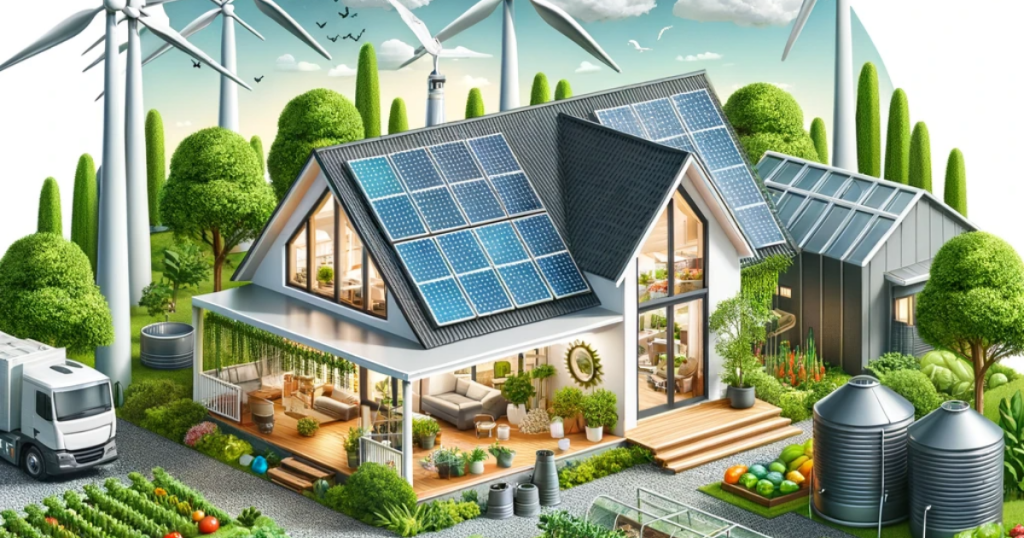
Water scarcity is a growing concern, and hydroponics addresses this issue by using significantly less water than traditional soil-based gardening.
Water Recycling:
Hydroponic systems recirculate water and nutrients, preventing waste. This conservation of resources contributes to global efforts to reduce water consumption.
Drought Resistance:
Hydroponics can be particularly beneficial in regions prone to drought, where traditional agriculture may be unsustainable.
Carbon Footprint
Hydroponics stands at the forefront of sustainable agriculture, significantly contributing to reducing our environmental impact. This innovative method plays a key role in diminishing the carbon footprint associated with traditional farming practices. By localizing food production, hydroponics slashes the need for extensive transportation of produce, which is a major source of greenhouse gas emissions.
Moreover, the elimination of soil cultivation in hydroponics means there are no emissions from soil tilling or the use of fossil fuel-powered farm machinery. This approach not only aligns with our environmental responsibilities but also paves the way for a greener, more sustainable future in food production. In essence, hydroponics offers us a path to nourish our communities while nurturing our planet.
Reduced Transportation:
By growing your produce, you reduce the environmental impact of transporting fruits and vegetables from distant locations.
Soil Conservation:
Traditional agriculture often leads to soil erosion and degradation. Hydroponics eliminates these concerns, as it doesn’t rely on soil.
Conclusion
In conclusion, hydroponic gardening offers a sustainable, environmentally friendly, and efficient way to cultivate a wide range of plants without soil. It empowers gardeners to grow fresh produce year-round, save resources, and reduce their carbon footprint. By choosing the right system, plants, and nutrient solutions, and avoiding common mistakes, you can experience the joy of growing your hydroponic garden. So, why not embark on this exciting journey and reap the rewards of bountiful, homegrown produce?
FAQs
1. Is hydroponics suitable for beginners?
Absolutely! Hydroponics can be adapted to various skill levels, and there are simple systems that are perfect for newcomers. Start small, gain experience, and expand your garden as you become more confident.
2. How much time does hydroponic gardening require?
The time commitment for hydroponic gardening is similar to that for traditional gardening. Expect to spend a few hours each week on maintenance tasks like nutrient management, pest control, and harvesting.
3. Can I grow organic produce using hydroponics?
Yes, you can grow organic produce hydroponically. By using organic nutrient solutions and pest control methods, you can maintain organic gardening principles in a soilless system.
4. What types of plants grow best in hydroponic systems?
Leafy greens, herbs, and small fruiting plants like tomatoes and peppers thrive in hydroponic setups. Experiment with different crops to see what works best for you.
5. Is hydroponics cost-effective in the long run?
While the initial setup may be more expensive than traditional gardening, the long-term savings on water, pesticides, and fertilizers often make hydroponics a cost-effective choice. Plus, the convenience and environmental benefits are compelling reasons to invest in hydroponics.




